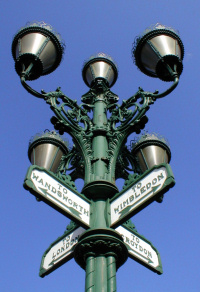Tooting
Tooting, Wandsworth
A densely populated multiracial district situated west of Streatham, recently reinvented as one of London’s coolest neighbourhoods

The name is of uncertain Anglo-Saxon origin and may have referred to ‘the people of the lookout place’. The manors of Tooting (subsequently Tooting Graveney) and Tooting Bec were in existence by the time of Domesday Book and each became the centre of a farming village over the course of the Middle Ages, in the valleys of the Wandle and Graveney rivers.
In the 18th century country homes began to appear, including Hill House at Tooting Graveney and Furzedown House in the locality that bears its name. Houses also lined the High Street and a few of these early buildings have survived.
The area attracted some villas and institutions from the mid-19th century, when Charles Dickens’ essay The Paradise at Tooting exposed the wrongdoings at a farming establishment for pauper children on Tooting Broadway.
Tooting Junction station opened in 1868 on the Tooting, Merton and Wimbledon Railway. This did not immediately stimulate suburban growth but later in the 19th century the area between the station and Tooting Broadway became the first part of Tooting Graveney to be filled with suburban housing.
Meanwhile, development spread towards Tooting Bec from Balham, although Tooting Common was preserved as open space. The mainline station was relocated to its present position in 1894 and renamed Tooting.
The London County Council built a cottage estate at Totterdown Fields in the early years of the 20th century, and the huge Tooting Bec lido opened in 1906, on the far eastern edge of the district.

The arrival of the Underground in 1926 completed Tooting’s transformation from a pair of villages into a London suburb; the medieval parish church was replaced and the fabulous Granada cinema was built on the Broadway.
Later residential development has mostly involved the replacement of former institutional buildings, including hospitals – although St George’s remains and is one of the biggest hospitals in the country. Its Atkinson Morley wing is shown in the photograph at the top of the page.*
Tooting has been called ‘Little South India’ for the size of its Asian – particularly Tamil – population and for its variety of affordable South Indian restaurants. The main streets have shops specialising in Asian sweets and other comestibles, jewellery and saris.
In recent years the district has also acquired a ‘hipster’ contingent and has apparently been dubbed ‘the new Shoreditch’ – unlikely as that may sound. Equally unexpectedly, travel guide Lonely Planet named Tooting as one the world’s coolest neighbourhoods in August 2017.
Perhaps because it has a silly sounding name, Tooting has been the setting for several television comedies, including Hugh and I and Citizen Smith, which used the Castle public house for location scenes. That pub is said to have been opened by John Wayne. (Other sources say he was a regular here. Hidden London does not believe this.)
Planetary expert Pete Mouginis-Mark named a Martian meteorite crater after his Tooting birthplace in 2005.
Tooting is (little-used) cockney rhyming slang for a light kiss, from Tooting Bec – a peck.
